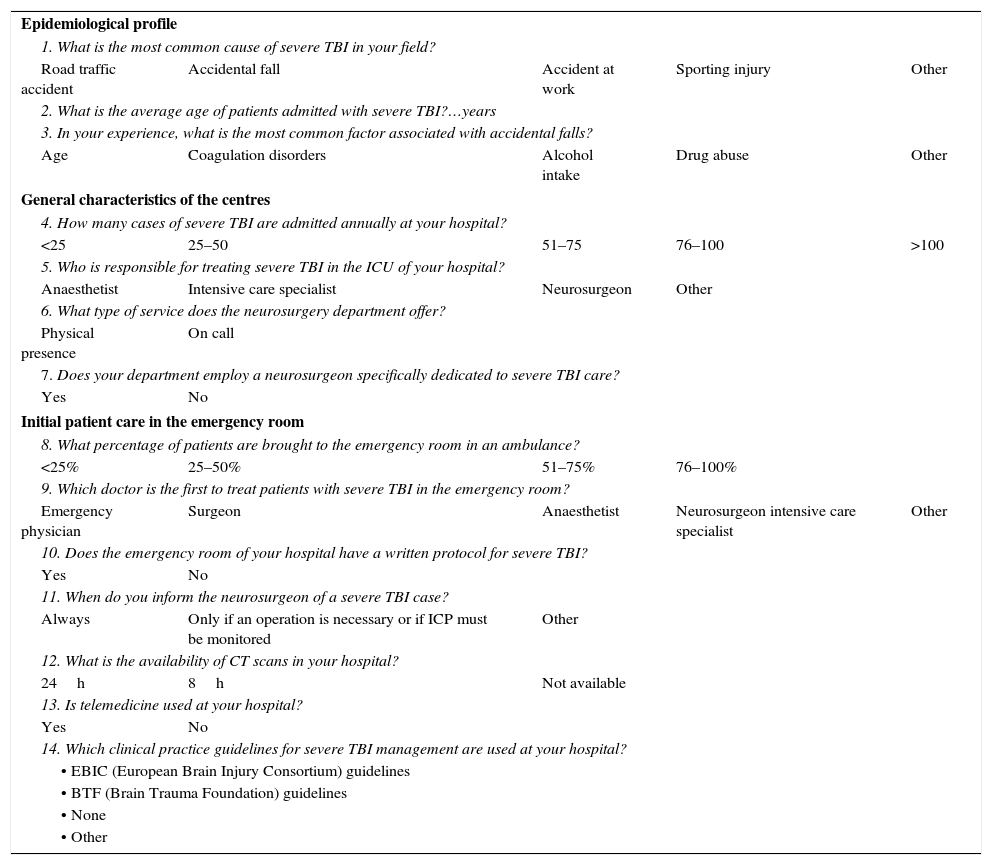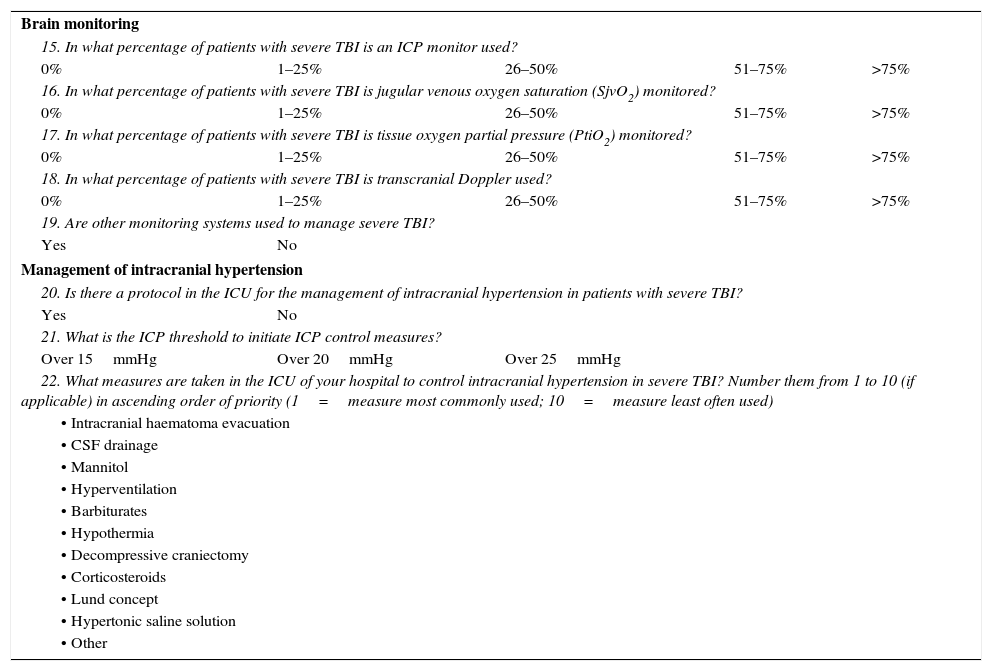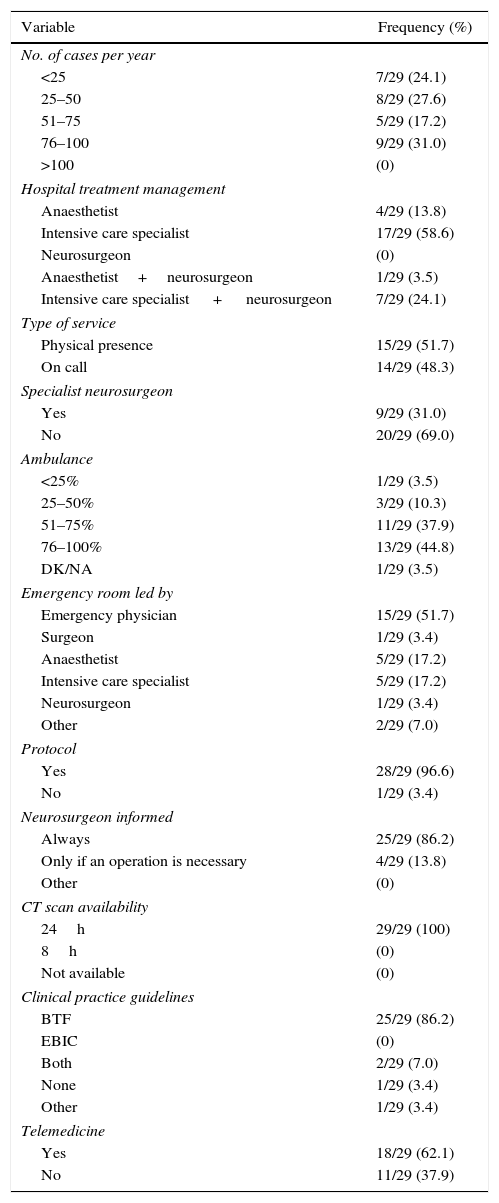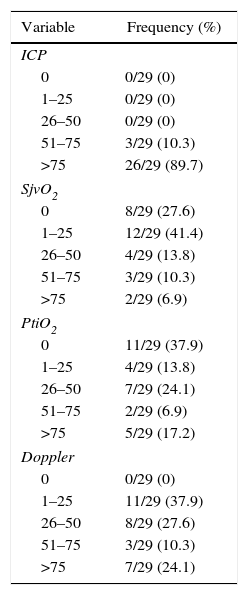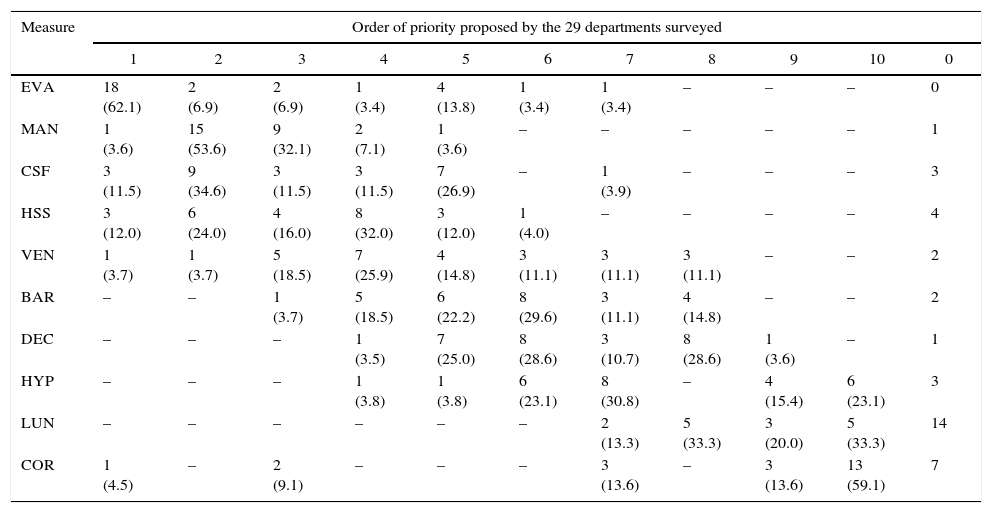The main objective of the study is to obtain knowledge about the organisation of care for severe head trauma as well as the initial management of these patients in Neurosurgical Departments in Spain.
Material and methodA 22-item questionnaire was designed and sent to 59 Neurosurgical Departments. The aim of the questionnaire was to collect data regarding the general profile of the patients with a severe head injury, the general characteristics of the hospitals, the initial care of these patients, the monitoring techniques used, and the measures used to control Intracranial pressure (ICP).
ResultsOf the 59 Neurosurgical Departments identified, 29 (49.2%) completed the questionnaire. There was a wide variability in the number of patients treated per year between the different departments. The leadership of care often fell (58.6%) on the intensive care specialist. Many (69%) of the departments did not have a neurosurgeon specially dedicated to the management and monitoring of these patients. The initial care in the Emergency department usually fell (51.7%) on the general medicine practitioner. The availability of computed tomography (CT) was universal. The use of telemedicine was highly variable. ICP monitoring was performed on more than 75% of patients in most (89.7%) of departments, but there was limited use of other monitoring techniques. Most Departments followed the recommendations of the Brain Trauma Foundation (BTF) guidelines for the control of ICP.
ConclusionsThe organisation of care and the initial management of severe head trauma in Spain is very similar to its neighbouring countries. However, there are shortcomings, such as low participation by a neurosurgeon in the initial management of these patients, insufficient use of telemedicine, and the low implementation of certain brain monitoring techniques (SjO2, PtiO2, and Doppler).
El objetivo fundamental del estudio es conocer la organización de la asistencia al traumatismo craneoencefálico grave así como el manejo inicial de estos pacientes en los servicios de neurocirugía de España.
Material y métodoSe diseñó un cuestionario de 22 preguntas que fue enviado a los 59 servicios de neurocirugía identificados. El objeto del cuestionario era conocer el perfil general de los pacientes con un trauma craneoencefálico grave, las características generales de los hospitales, la atención inicial de dichos pacientes, las técnicas de monitorización empleadas y las medidas encaminadas a bajar la PIC.
ResultadosDe los 59 servicios de neurocirugía identificados, 29 (49,2%) respondieron a la encuesta. Existía una amplia variabilidad en el número de pacientes atendidos al año entre los distintos servicios. La dirección de la asistencia recaía a menudo (58,6%) sobre el intensivista. Muchos (69%) de los servicios no disponían de neurocirujano con especial dedicación al manejo y seguimiento de estos pacientes. La atención en la puerta de urgencias recae de forma habitual (51,7%) sobre el médico generalista de urgencias. La disponibilidad de TAC era unánime. La utilización de la telemedicina era muy variable. La monitorización de la PIC se realizaba en más del 75% de los pacientes en la mayoría (89,7%) de servicios, pero existía poca implantación de otras técnicas de monitorización. Las medidas para el control de la PIC se realizaban de forma mayoritaria siguiendo las recomendaciones de las guías de práctica clínica de la BTF.
ConclusionesLa organización y manejo del traumatismo craneoencefálico grave en nuestro país es muy similar al de los países de nuestro entorno. Se observan, sin embargo, deficiencias tales como la escasa participación del neurocirujano en el manejo global inicial de estos pacientes, la utilización insuficiente de la telemedicina y la baja implantación de ciertas técnicas de monitorización cerebral (SjO2, ptiO2 y doppler).
Article

If it is the first time you have accessed you can obtain your credentials by contacting Elsevier Spain in suscripciones@elsevier.com or by calling our Customer Service at902 88 87 40 if you are calling from Spain or at +34 932 418 800 (from 9 to 18h., GMT + 1) if you are calling outside of Spain.
If you already have your login data, please click here .
If you have forgotten your password you can you can recover it by clicking here and selecting the option ¿I have forgotten my password¿.



